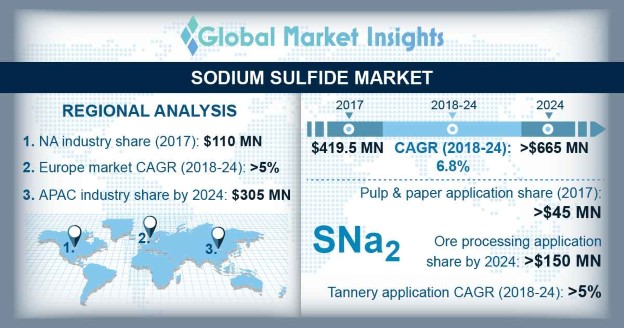Home > Chemicals & Materials > Specialty Chemicals > Custom Synthesis > Sodium Sulfide Market
Sodium Sulfide Market Size
- Report ID: GMI3006
- Published Date: Nov 2018
- Report Format: PDF
Sodium Sulfide Market Size
Sodium Sulfide Market size was over USD 415 million in 2017, witnessing a CAGR of 6.8% from 2018 to 2024. and industry expects consumption at over 945 kilo tons by 2024.
Rising operational costs and increasing stringent labor regulations in Germany, Italy, France and Belgium have shifted the leather production to several Asian nations including China, India, and South Korea. India has abundant raw material reserves with access to over 20% of the global cattle population and the labor-intensive leather industry provides employment to about 3 million poor citizens which may consolidate the tannery industry.
Chinese leather exports exceeded USD 78 billion in 2017, which indicates ample growth potential for the sodium sulfide market.
Low water availability, significant population rise, rapid city development, and technological advancements in water treatment have led to an increasing necessity of water reuse. In 2017, the global demand for freshwater witnessed a rise of over 60 billion cubic meters annually which presents ample opportunities for water treatment.
| Report Attribute | Details |
|---|---|
| Base Year: | 2017 |
| Sodium Sulfide Market Size in 2017: | 415 Million (USD) |
| Forecast Period: | 2018 to 2024 |
| Forecast Period 2018 to 2024 CAGR: | 6.8% |
| 2024 Value Projection: | 665 Million (USD) |
| Historical Data for: | 2013 to 2017 |
| No. of Pages: | 220 |
| Tables, Charts & Figures: | 259 |
| Segments covered: | Product, Grade, Application, and Region |
| Growth Drivers: |
|
| Pitfalls & Challenges: |
|
The product is routinely used in wastewater treatment for the removal of heavy metals ions such as mercury & lead that results in the formation of heavy metal sulfide particles over 2.5 µm in size, which can then be conveniently removed by sedimentation.
Na2S emits toxic pollutants such as hydrogen sulfide gas through the dissociation process during downstream operations in the pulp & paper industry which may restrain market growth. Moreover, sulfide-rich effluents are commonly associated with ill-effects including sewer corrosion, malodours, and toxicity to humans, livestock & agriculture, which may further hamper the sodium sulfide market growth.

